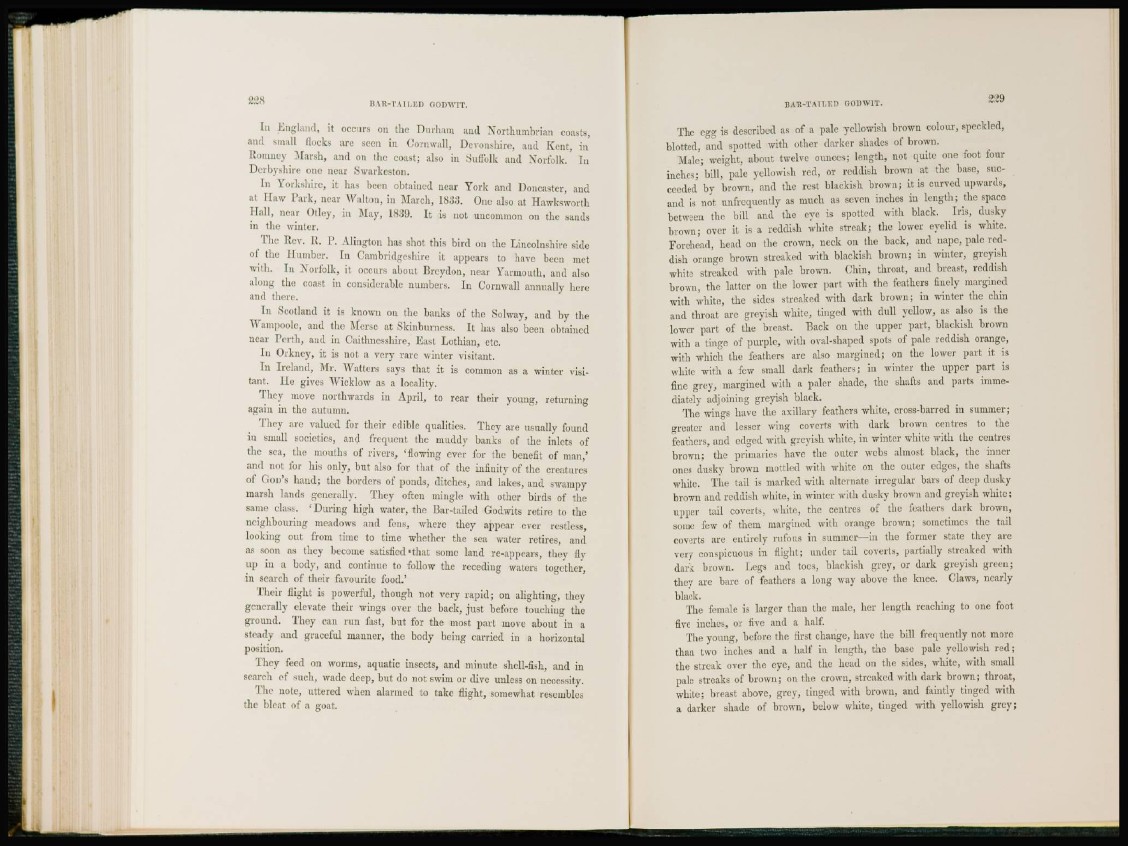
228 BAR-TAILED GODWTT.
In England, it occurs on the Durham and Northumbrian coasts,
and small (locks are seen in Cornwall, Devonshire, and Kent, in
Bomney Marsh, and on the coast; also in Suffolk and Norfolk. In
Derbyshire one near Swarkeston.
In Yorkshire, it has been obtained near York and Doncaster, and
ai Haw Park, near Walton, in March, 1833. One also at Hawksworth
Hall, near Otley, in May, 1839. It is not uncommon on the sands
in the winter.
The Rev. It. 1'. Alington has shot this bird on the Lincolnshire side
of the 1 lumber. In Cambridgeshire it appears to have been met
with. In Norfolk, it occurs about Breydon, near Yarmouth, and also
along the coast in considerable numbers. In Cornwall annually here
and there.
I n Scotland it is known on the banks of the Solway, and by the
Wampoolo, and the Morse at Skinburness. It has also been obtained
near Perth, and in Caithnesshire, East Lothian, etc.
I n Orkney, it is not a very rare winter visitant.
I n Ireland, Mr. Watters says that it is common as a winter visitant,
lie gives Wicklow as a locality.
They move northwards in April, to rear their young, returning
again in the autumn.
They are valued for their edible qualities. They are usually found
in small societies, and frequent the muddy banks of the inlets of
the sea, the mouths of rivers, 'flowing ever for the benefit of man,'
and not lor his only, but also for that of the infinity of the creatures
of (ion's hand; the borders of ponds, ditches, and lakes, and swampy
marsh lands generally. They often mingle with other birds of the
same class. 'During high water, the Bar-tailed Godwits retire to the
neighbouring meadows and fens, where they appear ever restless,
looking out from time to time whether the sea water retires, and
as soon as they become satisfied "that some land re-appears, they fly
up in a bodv, and continue to follow the receding waters together,
in search of their favourite food.'
Their flight is powerful, though not very rapid; on alighting, they
generally elevate their wings over the back, just before touching the
ground. They can run fast, but for the most part move about in a
steady and graceful manner, the body being carried in a horizontal
position.
They feed on worms, aquatic insects, and minute shell-fish, and in
search of such, wade deep, but do not swim or dive unless on necessity.
The note, uttered when alarmed to take flight, somewhat resembles
the bleat of a goat.
BAR-TAILED GODWIT. 2:39
The egg is described as of a pale yellowish brown colour, speckled,
blotted, and spotted with other darker shades of brown.
Male; weight, about twelve ounces; length, not quite one foot four
inches; bill, pale yellowish red, or reddish brown at the base, succeeded
by brown, and the rest blackish brown; it is curved upwards,
and is not unfrequcntly as much as seven inches in length; the space
between the bill and the eye is spotted with black. Iris, dusky
brown; over it is a reddish white streak; the lower eyelid is white.
Forehead, head on the crown, neck on the back, and nape, pale reddish
orange brown streaked with blackish brown; in winter, greyish
white streaked with pale brown. Chin, throat, and breast, reddish
brown, the latter on the lower part with the feathers finely margined
with white, the sides streaked with dark brown; in winter the chin
and throat are greyish white, tinged with dull yeBow, as also is the
lower part of the breast. Back on the upper part, blackish brown
with a tinge of purple, with oval-shaped spots of pale reddish orange,
with which the feathers arc also margined; on the lower part it is
white with a few small dark feathers; in winter the upper part is
fine grey, margined with a paler shade, the shafts and parts immediately
adjoining greyish black.
The wings have the axillary feathers white, cross-barred in summer;
greater and lesser wing coverts with dark brown centres to the
feathers, and edged with greyish white, in winter white with the centres
brown; the primaries have the outer webs almost black, the inner
ones dusky brown mottled with white on the outer edges, the shafts
wdiite. The tail is marked with alternate irregular bars of dee]) dusky
brown and reddish white, in winter with dusky brown and greyish white;
upper tail coverts, white, the centres of the feathers dark brown,
some few of them margined with orange brown; sometimes the tail
coverts are entirely rufous in summer—in the former state they are
very conspicuous in flight; under tail coverts, partially streaked with
dark brown. Legs and toes, blackish grey, or dark greyish green;
they are bare of feathers a long way above the knee. Claws, nearly
black.
The female is larger than the male, her length reaching to one foot
five inches, or five and a half.
The young, before the first change, have the bill frequently not more
than two inches and a half in length, the base pale yellowish red;
the streak over the eye, and the head on the sides, white, with small
pale streaks of brown; on the crown, streaked with dark brown; throat,
white; breast above, grey, tinged with brown, and faintly tinged with
a darker shade of brown, below white, tinged with yellowish grey;